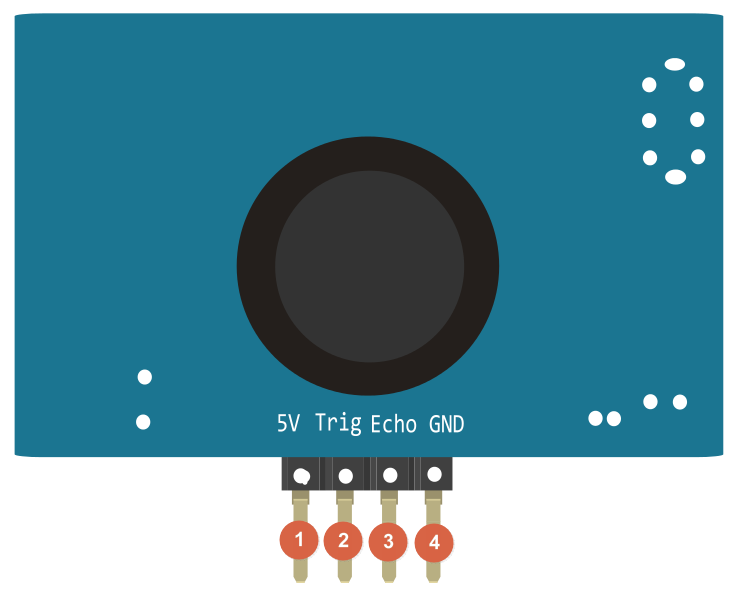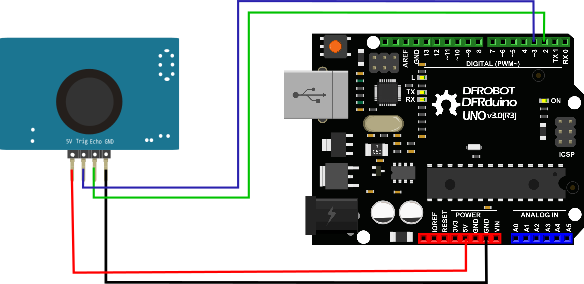Weather proof_Ultrasonic_Sensor_SKU___SEN0207 - jimaobian/DFRobotWiki GitHub Wiki

Most ultrasonic distance sensors aren't waterproof which can be a problem if you need your project to withstand the elements outdoors. No need to worry any more! We have developed waterproof ultrasonic distance sensors with a waterproof sealed emitter. This sensor is suitable for outdoor applications such as car reversing sensors, security alarms, industrial inspection, etc. What will you make?
- Operating Voltage: 5V DC
- Static Current: 5mA
- Working Current: 30mA
- Working Range: 25cm ~ 4.5m
- Resolution: 0.5cm
- Detecting Angle: < 50°
- Working Temp: -10 ~ 70°C
- Size: 41mm x 28.5mm
| ---------------------------------------------------- | |
 |
|-----------------------------------------------|
| | |
|-------------------------------------------|
| | | | |
|-----------|----------|----------------|
| **LABEL** | **NAME** | **FUNCTION** |
| 1 | 5V | Power Input + |
| 2 | Trig | Trigger Signal |
| 3 | Echo | Echo Signal |
| 4 | GND | GND | | | |
This tutorial will demonstrate how to use the Weather-proof Ultrasonic Sensor to measuring distance.
 A short ultrasonic pulse is transmitted at the time 0, reflected by an object. The sensor receives this signal and converts it to an electric signal. The next pulse can be transmitted when the echo fades. This time period is called cycle period. The recommend cycle period should be no less than 50ms. If a 10μs width trigger pulse is sent to the signal pin, the ultrasonic module will output eight 40kHz ultrasonic signals and detect the echo back. The measured distance is proportional to the echo pulse width and can be calculated by the formula above. If no obstacle is detected, the output pin will give a 38ms high level signal.
A short ultrasonic pulse is transmitted at the time 0, reflected by an object. The sensor receives this signal and converts it to an electric signal. The next pulse can be transmitted when the echo fades. This time period is called cycle period. The recommend cycle period should be no less than 50ms. If a 10μs width trigger pulse is sent to the signal pin, the ultrasonic module will output eight 40kHz ultrasonic signals and detect the echo back. The measured distance is proportional to the echo pulse width and can be calculated by the formula above. If no obstacle is detected, the output pin will give a 38ms high level signal.
| ### Requirements |
-
Hardware
- Arduino UNO x1
- Battery Capacity Indicator x1
- Software
-
- Arduino IDE V1.6.9 Click to Download Arduino IDE from Arduino®
| ### Connection Diagram |

#define ECHOPIN 2// Pin to receive echo pulse
#define TRIGPIN 3// Pin to send trigger pulse
void setup(){
Serial.begin(9600);
pinMode(ECHOPIN, INPUT);
pinMode(TRIGPIN, OUTPUT);
}
void loop(){
digitalWrite(TRIGPIN, LOW); // Set the trigger pin to low for 2uS
delayMicroseconds(2);
digitalWrite(TRIGPIN, HIGH); // Send a 10uS high to trigger ranging
delayMicroseconds(10);
digitalWrite(TRIGPIN, LOW); // Send pin low again
int distance = pulseIn(ECHOPIN, HIGH,26000); // Read in times pulse
distance= distance/58;
Serial.print(distance);
Serial.println(" cm"); �
delay(50);// Wait 50mS before next ranging
}There are no questions about this product yet. If you have any problems or suggestions, you are welcome to email us or post on the DFRobot forum!
 For any questions/advice/cool ideas to share, please visit the DFRobot Forum or email [email protected]
For any questions/advice/cool ideas to share, please visit the DFRobot Forum or email [email protected]
 get it from dfrobot store
get it from dfrobot store